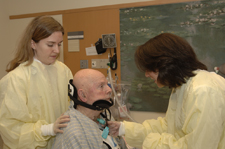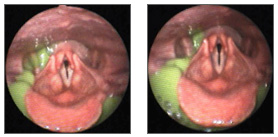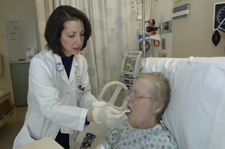Diagnosis and Treatment Services and PMV Evaluation
Our speech-language disorders program offers the full spectrum of
diagnostic services, therapeutic interventions and educational programs for
a wide range of speech/language disorders. We provide evaluation,
counseling and treatment for patients with oral and pharyngeal swallowing
disorders caused by a stroke, ALS, Parkinson's disease, brain tumors,
surgery, or radiation therapy to the neck.
Our diagnostic testing and treatment services include:
- Passy-Muir One-Way Speaking Valves
- Videofluoroscopy
- Fiber Optic Endoscopic Evaluation of Swallowing (FEES)
- Swallowing Therapy
Passy-Muir Valve Evaluation
 A Passy-Muir Valve is a one-way valve that can be worn at the end of a
tracheostomy tube to allow a patient to speak. The patient is still able to
breathe in through the tracheostomy tube, but the Passy-Muir Valve closes
when the patient exhales, directing the air through the vocal cords for
voice production and up into the mouth to be shaped into speech. The
speech-language pathologist collaborates closely with a registered nurse
and/or respiratory therapist if the patient is using a mechanical
ventilator to breathe.
A Passy-Muir Valve is a one-way valve that can be worn at the end of a
tracheostomy tube to allow a patient to speak. The patient is still able to
breathe in through the tracheostomy tube, but the Passy-Muir Valve closes
when the patient exhales, directing the air through the vocal cords for
voice production and up into the mouth to be shaped into speech. The
speech-language pathologist collaborates closely with a registered nurse
and/or respiratory therapist if the patient is using a mechanical
ventilator to breathe.
Swallowing (Dysphagia) Evaluation and Treatment Services
Once a nurse or physician identifies a patient as having difficulty eating or swallowing, a consultation is requested from the speech-language pathologist. The therapist will first perform an evaluation at the bedside to determine if the patient is safe to eat or drink. Further tests may be recommended, which include procedures to visualize the swallowing mechanism and to determine whether foods or liquids are entering the airway.
Our goal is to find a way for our patients to eat and swallow safely to ensure that food and/or liquid goes down the esophagus and not the "wrong way" into the lungs. In many cases we can suggest diet modifications or recommend changes in head position that improve airway protection, allowing patients to continue to eat and drink even if they have difficulty swallowing or experience coughing or choking while eating and drinking.
Videofluoroscopy
Often referred to as a videoswallow study or modified barium swallow study,
videofluoroscopy is a radiological test performed jointly by a
speech-language pathologist and a radiologist. It allows clinicians to
visualize the anatomy and physiology of the swallowing mechanism to
determine the patient's ability to safely swallow with the airway
protected. Patients are given small amounts of various food and liquid
consistencies coated with barium. Barium is used because it is visible by
X-ray. Real foods/liquids are added to the barium to make the testing
sample similar to the food consistency eaten and drunk at home. Patients
are not given large amounts and it is not necessary to fast prior to this
procedure. During the procedure, therapists may attempt treatment
techniques to improve the effectiveness of the swallow. The speech-language
pathologist reviews the videotape with the patient and makes specific
recommendations regarding diet, the safest way to eat and drink and ways to
prevent medical complications, such as pneumonia.
Fiberoptic Endoscopic Evaluation of Swallowing (FEES)
FEES is a swallowing test in which video pictures are taken of the voice
box (larynx) and throat (pharynx) while eating and drinking. A gel is used
to make the nose feel numb. A very thin, bendable tube is then placed in
the nose and down the throat. Patients may be asked to swallow, speak,
cough and/or clear their throat. You will then be given some colored food
and liquids to eat and drink. Video pictures are taken as you perform these
activities. Once the test is completed, the speech-language pathologist
reviews the examination results with you. A written report of your
evaluation will be sent to your doctor.
Swallowing Therapy
Once the diagnosis is established for a particular swallowing disorder swallowing therapy may be indicated. Swallowing therapy consists of patient education in food consistencies, positioning techniques and/or other physical exercises to improve the strength, timing and coordination of the swallow.



